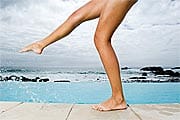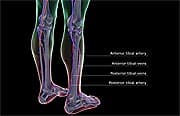Life Extension Magazine®
For the last 30 years, millions of European women have been using a doctor-prescribed citrus fruit extract to attain healthier, smoother, and shapelier legs. Now, US women have access to the same European wonder drug, available without a doctor’s prescription as a nutraceutical product, called micronized diosmin. Micronized diosmin has been clinically proven to produce healthier-looking legs by healing swollen ankles, spider and varicose veins, and leg ulcers. While current US drug treatments for cosmetic improvement in the legs have not achieved good clinical efficacy, micronized diosmin has enjoyed an outstanding 30-year record of research testing and success in Europe.1 In this article, you’ll learn about the new nonprescription form of the European drug, micronized diosmin, and discover how it can enhance the appearance of the legs by reducing ankle swelling, improving the appearance of varicose and spider veins, and restoring healthy vascular function in people suffering from chronic venous disorders. Micronized Diosmin Restores Healthy Function to Stressed-Out LegsAge and gravity are the enemies of healthy veins. Over time, leg veins may become weakened, twisted, dilated, and thickened. Blood may flow backwards and collect in the vein, causing it to swell. Aside from the visible, unsightly cosmetic issues, spider veins and varicose veins cause pain and itching, while scratching them can lead to ulcerations. Mainstream doctors treat these swollen and unsightly veins with lasers, radiofrequency ablation, and surgery. Micronized diosmin prolongs the vasoconstrictor effect of noradrenalin on the vein wall and by doing so, increases venous tone, thereby reducing the blood pooling that can lead to swollen leg veins.4 With micronized diosmin, people who suffer from swollen veins may be able to avoid expensive medical procedures, and research has shown that those who must undergo such procedures may see improved clinical outcomes when it is used pre- and post-operatively. In a study of 245 patients with varicose vein disease who underwent surgical removal of affected veins, those given micronized diosmin pre- and post-therapy (two weeks before and for 30 consecutive days after surgery) achieved measurable reduction in postoperative hematomas, pain severity, and limb heaviness, as well as better exercise tolerance and improved quality of life scores.5 Protection Against Varicose VeinsThe role of the legs’ venous system is to return deoxygenated blood from the lower extremities to the heart. To counterbalance the effect of gravity, leg veins are equipped with a series of one-way valves that prevent the return of blood flow to the feet. In people with healthy venous valves, each contraction of the calf muscles pumps venous blood toward the heart. As valves become damaged, they allow retrograde flow of blood toward the feet, leading to hypertension in the veins and further complications linked to progression of chronic venous disease. This leads to damage of the venous wall, the appearance of varicose veins, and further damage leading to the progression of venous disease.
Studies show that micronized diosmin protects the one-way venous valves from leukocyte-induced inflammation and destruction.6 Micronized diosmin also increases venous tone and reduces venous stretching and blood pooling.7 This increases blood flow toward the heart and reduces venous high blood pressure present in patients suffering from chronic venous disease. Dangers of Chronic Venous Insufficiency (CVI)If your legs feel heavy, tired, or achy, or if you feel pain in your legs shortly after walking, you might have chronic venous insufficiency (CVI).
CVI is caused by a deterioration of the one-way flaps in veins designed to keep blood flowing toward the heart. With each step taken, venous flaps serve as leaflet valves that maintain blood flow in the proper direction. As leg muscles relax, the venous valves close, preventing blood from flowing back down the leg. CVI generally affects deep veins in the leg. Varicose veins can also contribute to CVI. Doctors treat CVI with compression bandaging, drugs, sclerotherapy (injections), and surgery. The process of venous wall stretching and dilation is painful and generally leads to leg heaviness and a sensation of swelling. Although generally not life-threatening, CVI can decrease quality of life; left untreated, it can lead to serious medical conditions including phlebitis, the inflammatory venous condition that afflicted President Richard Nixon, and deep vein thrombosis (DVT), suffered by Vice-President Dan Quayle as a result of extended air travel. DVT can cause a potentially life-threatening blood clot. Risk factors for CVI include being in a profession that involves standing or sitting for long periods of time, age, gender (women older than 50 are more prone than men to CVI), being pregnant, physical activity, smoking, body fatness, height (taller people are at greater risk) and a family history of varicose veins. Studies using micronized diosmin for the treatment of CVI reveal that in as little as 30 days, most patients suffering from this condition see significant improvement in pain, sensation of swelling, and cramps.8,9 A multicenter international trial, conducted in 23 countries over two years, in which 5,052 symptomatic patients were enrolled, evaluated the efficacy of micronized diosmin in the treatment of chronic venous insufficiency.9 Researchers noted continuous clinical improvement throughout the study, as well as improvements in quality-of-life scores for participants. Diosmin Blocks The Primary Cause of All Chronic Venous DiseaseResearchers recently discovered that the interaction between white blood cells (leukocytes) and the venous endothelium (inner layer of vein wall) is the process underlying all clinical manifestations of chronic venous disease. Thanks to its unique action in inhibiting this leukocyte-endothelial interaction, micronized diosmin is the only nutraceutical treatment shown to be effective and protective against the progression of chronic venous disease.
Leukocyte-endothelium interaction is caused by the expression of adhesion molecules on the surface of leukocytes and endothelial cells. As a result of this interaction, leukocytes release proteolytic enzymes and other toxic components, producing a massive inflammatory response in small veins and capillaries. This leads to the accumulation of red blood cells, fluids, and proteins that cause ankle swelling (edema) and inflammation.10 Over time, this inflammatory process may cause leg veins and the skin to ulcerate. Diosmin protects capillaries and the microcirculation from inflammation and vascular-destructive compounds while inhibiting white blood cell activation, migration, and adhesion. Likewise, micronized diosmin prevents tissue damage to blood vessel valves; preventing venous blood backflow. Micronized diosmin is the only treatment that is effective in protecting patients from the symptoms of chronic venous disease from the earliest stages up to the most severe stages.11-14 After reviewing a number of medical studies using micronized diosmin, one researcher concluded that micronized diosmin should be “the first-line treatment for edema and symptoms of CVI at any stage of the disease” and recommended its use “in conjunction with sclerotherapy, surgery, and/or compression therapy or as an alternative treatment when other treatments are not indicated or not feasible.”7
| ||||||||
Healing Venous Leg Ulcers with Micronized DiosminVenous ulcers affect 500,000 Americans every year and account for 80 to 90% of all leg ulcers. They typically occur in people with a history of leg swelling, varicose veins, or a history of blood clots in either the superficial or the deep veins of the legs. Ulcers may affect one or both legs.
Venous ulcers can occur on either side of the lower leg, usually above the ankle and below the knee. A shallow wound with a reddish base develops when the leg veins’ valves become damaged and fail to adequately move blood back toward the heart. Some ulcers can be covered with pale yellow fibrous tissue and exude pus and extracellular fluid if the ulcer becomes infected. Studies show that micronized diosmin helps heal leg ulcerations by inhibiting the synthesis of inflammatory prostaglandins and free radicals.15 Micronized diosmin also decreases microvascular leakage and inhibits white blood cell trapping and migration.16 One study found that treatment with micronized diosmin led to complete healing of infected leg ulcers.17 A multicenter, randomized, controlled trial tested micronized diosmin in addition to standard compression stocking therapy versus placebo for two months in patients with leg ulcers.18 The study group consisted of 140 men and women ranging in age from 18 to 85 years who were undergoing standardized local care of leg ulcer. A significantly larger number of patients (47% in the diosmin group vs. 28% in the placebo group) experienced complete healing of venous ulcers at the end of six months.
A number of randomized prospective studies using diosmin as an adjunct to conventional treatment demonstrate the efficacy of the supplement in helping to heal leg ulcers. In a research review, conventional treatment (compression and local care) in addition to a daily dose of diosmin was compared with conventional treatment plus placebo or with conventional treatment alone. The results showed a clear benefit of adjunctive micronized diosmin treatment over conventional therapy alone.10 These results confirm that venous ulcer healing is accelerated by adjunctive treatment with diosmin. SummaryMicronized diosmin is the most widely used drug (used by tens of millions of European women) to achieve shapelier, smoother and more well-defined looking legs. Micronized diosmin rapidly improves the symptoms and appearance of varicose and spider veins.
Of all the drugs used clinically for leg swelling reduction, only micronized diosmin has shown to be effective in clinical trials involving leg swelling (edema) associated with venous disorders. Edema creates unsightly ‘cankles,’ a term used to denote the loss of contour between calves and ankles. Micronized diosmin is the only oral treatment shown to be effective from the earliest symptoms of chronic venous disease up to the most severe stages. Micronized diosmin is highly effective at improving the appearance of cosmetically unattractive venous disorders, including varicose veins, spider veins, leg ulcers, and swollen ankles. Micronized diosmin possesses a unique and clinically proven mode of action that addresses all the disabling aspects of venous disease affecting the veins, lymph glands, and microcirculation. In patients suffering from CVI, diosmin provides significant relief from pain, heavy legs, and cramps. No other oral medication except micronized diosmin has ever been shown to relieve the symptoms or reactionary bleeding experienced by patients after hemorrhoidectomy. Diosmin also provides relief from lymphedema following conventional treatment for breast cancer. Micronized diosmin enjoys an outstanding safety record unrivaled by any other drug used to treat venous disorders.The overwhelming majority of published studies show that diosmin is generally nontoxic at recommended doses, including studies involving pregnancy, and is relatively free from drug interactions. However, those who are pregnant or who take any prescription medications should check with a physician before taking micronized diosmin.
If you have any questions on the scientific content of this article, please call a Life Extension® Health Advisor at 1-800-226-2370. | |||||||
| References | |||||||
| 1. Angiology. 1994 Jun;45(6):419-28. 2. Methods Find Exp Clin Pharmacol. 1998 Apr;20(3):211-5. 3. J Pharm Sci. 2002 Jan;91(1):32-40. 4. Pharmacol Res. 1991 Oct;24(3):253-6. 5. Angiol Sosud Khir. 2006;12(3):53-60. 6. Eur J Vasc Endovasc Surg. 2004 Nov;28(5):484-93. 7. Angiology. 2003 Jul;54 Suppl 1:S33-S44. 8. Acta Chir Iugosl. 2008;55(4):53-9. 9. Angiology. 2002 May;53(3):245-56. 10. Angiology. 2005;56 Suppl 1:S33-9. 11. Angiology. 2000 Jan;51(1):19-23. 12. Microcirculation. 2000;7(6 Pt 2):S29-S34. 13. Angiology. 2001 Aug;52 Suppl 1S49-S56. 14. Int Angiol. 1995 Sep;14(3 Suppl 1):36-8. 15. Drugs. 2003;63(1):71-100. 16. Angiol Sosud Khir. 2007;13(2):47-55. 17. Int J Angiol. 2001 Jan;10(1):41-4. 18. Phlebology. 1999;14:151-7. 19. Angiology. 1994 Jun;45(6 Pt 2):574-8. 20. Int J Gynaecol Obstet. 1997 May;57(2):145-51. 21. Int J Microcirc Clin Exp. 1995;15 Suppl 1:41-4. 22. Int Angiol. 1989 Oct-Dec;8(4 Suppl):15-8. 23. Int Angiol. 1995 Sep;14(3 Suppl 1):39-43. 24. Angiology. 1997 Jan;48(1):77-85. |




